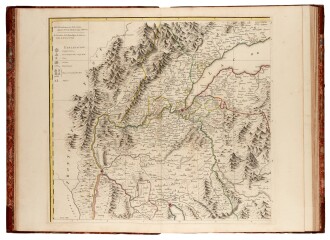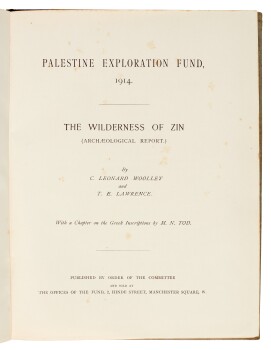Sotheby’s is delighted to present Books and Manuscripts: A Summer Miscellany. As the title suggests the sale includes a unique presentation of a range of material including natural history, travel and science as well as a selection of literature and history.
Daniel Giraud Elliot was perhaps the most significant American ornithologist after Audubon, and his two greatest works, both printed in America, are represented by attractive copies in this section of the sale. His Monograph of the Phasianidae (lot 31) contains perhaps the best illustrations of pheasants ever made, on a par with the lithographs made under the auspices of his contemporary John Gould, whose book on the Trogons is also in the sale (lot 37). This part of the sale also includes fine atlases by Gerard Mercator (inventor of the term “atlas”, lot 48) and Abraham Ortelius (lot 52). There is also a fine cartographical work by Vincenzo Coronelli, most famous for building a pair of giant globes for Louis XIV, which are illustrated in his Atlante Veneto (lot 21). Other subjects covered include topography (notably a fine book of views of Venice by Carlevaris, lot 19), science (a fine, unrecorded letter by Charles Darwin on the voyage of the Beagle, lot 23), and medicine (a seventeenth-century book of remedies, lot 47).
The sale also includes a fine T.E. Lawrence collection assembled over many decades by Mr Alan Milne, including the US copyright edition of Seven Pillars of Wisdom, the printer’s set of Proofs before letters of the illustrations for the 1926 Subscribers’ edition and 45 other lots. From a number of consignors, including the actor Steven Berkoff, come major Oscar Wilde property, including a letter outlining the plot of The Importance of Being Earnest, a presentation copy of the deluxe 1/100 first edition of the same work, and the authorial manuscript for “Confessions of Tastes, Habits and Convictions”. Other highlights a group of original “Cottingley Fairies” photographs (relating to one of the world greatest ever “Fairies” hoaxes, famously duping the creator of Sherlock Holmes Sir Arthur Conan Doyle), letters by Churchill and Gandhi, and first editions of key novels by Cervantes, Jane Austen and James Joyce.
The sale also includes a series of 17 manuscript lots relating to Israel, chiefly in Hebrew. These include letters and documents by leading Zionists such as Theodor Herzl, Israeli politicians including significant letters by David Ben Gurion, and cultural figures such as Chaim Bialik.
Travel, Maps, Natural History, Science and Medicine
English Literature, History, Children’s Books and Illustrated

View Lot
- 1907-09
- 1911-14
- 1911-14
- 1914
- 1914-26
- 1922-1923
- 1928-1932
- 1922-1927
- 1935
- 1936
-
1907-09To aid the study of his BA dissertation while at Jesus College Oxford Lawrence undertakes extended summer bicycle tours of France in search of castles which he measures and photographs. His interest in architecture spurs him towards the crusades and in the summer of 1909 he travels to Lebanon and Syria recording the castles there. His findings form the basis for his thesis and he achieves a first class degree in July 1910. The letter he writes to his mother during the earlier trip, on 28 August 1908, describing Chartres Cathedral, is one of the most revealing he writes from this early period. It is published in a special limited edition by the Corvinus Press after his death.
View Lot -
 1911-14Lawrence works as an archaeologist at the site of Carchemish in Mesopotamia from 1911-14 under the direction of his lifelong friend D. G. Hogarth. The archaeological dig in northern Syria, coming at the end of his walking tour of Syria when researching crusader castles, is a key moment in forming Lawrence's devotion to the Middle East.
1911-14Lawrence works as an archaeologist at the site of Carchemish in Mesopotamia from 1911-14 under the direction of his lifelong friend D. G. Hogarth. The archaeological dig in northern Syria, coming at the end of his walking tour of Syria when researching crusader castles, is a key moment in forming Lawrence's devotion to the Middle East.
View Lot -
 1911-14This period sees him immersed in the life of a turbulent region. He is arbitrating disputes between Arabs and Kurds and trying to resolve disputes with the German engineers then constructing the Berlin to Baghdad railway. Lawrence cultivates an intimate friendship with an Arab youth, Dahoum. The friendship goes some way to persuading Lawrence of the capacity of the Arabs for regeneration, on their own terms and without repudiating their traditions and culture. As part of his project to improve his Arabic he translates two children’s stories from Arabic into English. These are published in a special limited edition after his death.
1911-14This period sees him immersed in the life of a turbulent region. He is arbitrating disputes between Arabs and Kurds and trying to resolve disputes with the German engineers then constructing the Berlin to Baghdad railway. Lawrence cultivates an intimate friendship with an Arab youth, Dahoum. The friendship goes some way to persuading Lawrence of the capacity of the Arabs for regeneration, on their own terms and without repudiating their traditions and culture. As part of his project to improve his Arabic he translates two children’s stories from Arabic into English. These are published in a special limited edition after his death.
View Lot -
 1914During January and February 1914, Lawrence and Woolley, in the company of a British Army surveying detachment, map the Negev region of the Sinai peninsula, then under Turkish suzerainty. The exercise is carried out under the guise of an archaeological survey, although the real aim is to update maps for the impending war.
1914During January and February 1914, Lawrence and Woolley, in the company of a British Army surveying detachment, map the Negev region of the Sinai peninsula, then under Turkish suzerainty. The exercise is carried out under the guise of an archaeological survey, although the real aim is to update maps for the impending war.
View Lot -

Lot 104
LAWRENCE, T.E.
Illustrations for Seven Pillars of Wisdom Produced for T.E. Lawrence. [?1926/7], the Printer’s set of proof plates for Seven Pillars of Wisdom, the most complete set known1914-26Lawrence joins the Arab Bureau at the outbreak of war and is later assigned as an advisor to Prince Faisal. Lawrence galvanises the Arab forces, seizing the Red sea port of Aqaba in 1917. At the Paris Peace Conference after the war Lawrence seeks to secure pledges for Arab Independence, but is frustrated by the extension of Imperial Control over much of the former Turkish Empire. Regarded as a glamorous war hero he sets about writing his celebrated account of his campaigns, Seven Pillars of Wisdom, which, after a series of misadventures including allegedly losing the first manuscript draft at Reading station, is finally published in full in a special subscribers’ edition in 1926.
View Lot -

Lot 109
LAWRENCE, T.E.
"The 200 Class Seaplane Tender" [in] The History of the Royal Airforce Marine Craft 1918-1986, Canimpex Publishing, 1986
Estimate £100/1501922-1923Despite having risen to the rank of Colonel in the Army Lawrence resigns from the Colonial Office and joins the RAF as an ordinary aircraftman under the name “John Hume Ross”. His subterfuge is uncovered by the press and he is discharged. In March 1923 he is re-enlisted in the tank corps as “T.E. Shaw”. In 1925 he is permitted to transfer back to the RAF, where he remains until February 1935. During this period he develops a love affair with Brough Superior motorcycles and other machinery, working for the RAF on the design of seaplane tenders and air-sea rescue craft.
View Lot -
 1928-1932Lawrence works assiduously on what turns out to be a classic translation of Homer’s Odyssey, ultimately published in a deluxe edition by the famous American typographer Bruce Rogers "Here, at last, was a man who could make Homer live again - a man of action who was also a scholar and who could write swift and graphic English." (Rogers). The edition comes to be regarded as one of the most beautiful books of the twentieth century.
1928-1932Lawrence works assiduously on what turns out to be a classic translation of Homer’s Odyssey, ultimately published in a deluxe edition by the famous American typographer Bruce Rogers "Here, at last, was a man who could make Homer live again - a man of action who was also a scholar and who could write swift and graphic English." (Rogers). The edition comes to be regarded as one of the most beautiful books of the twentieth century.
View Lot -

Lot 119
LAWRENCE, T.E.
The Mint: Notes made in the R.A.F. Depot between August and December 1922, and at Cadet College in 1925. Regrouped and Copied in 1927 and 1928 at Aircraft Depot, Karachi, carbon copy typescript of the American copyright edition
Estimate £2000-30001922-1927Lawrence writes "The Mint" as an account of barrack-room life within the RAF (the title likening RAF training to a coin factory where men are stamped like coins out of blank metal). A fine piece of writing, it is composed over several years, set aside after his dismissal in 1923, and then taken up again when he is transferred to India in 1927. Owing to potentially controversial passages Lawrence guarantees that the book will not be published until 1950, but a manuscript copy finds its way to America, where a copyright edition is required in order to control publication.
View Lot -

Lot 120
HART, B.H. LIDDELL and SIR RONALD STORRS.
Lawrence of Arabia. The Corvinus Press, May 1936, one of 24 special copies for the authors, this no.9 of 12 printed for Hart and signed by both authors
Estimate £1500/20001935Lawrence is killed in a motorcycle accident on 19 May. Among events celebrating his life that year is a literary lunch organised by Foyle’s at Grosvenor House, where B.H. Liddell Hart and Sir Ronald Storrs give speeches.
View Lot -

Lot 122
LAWRENCE, T.E.
Crusader Castles. Waltham St. Lawrence: The Golden Cockerel Press, 1936, 2 volumes, number 263 of 1000 copies, with reproductions of drawings, plans and sketches and 2 large folding maps
Estimate £800/12001936After Lawrence's death in 1935, there is a great deal of interest in his work and ideas. The partners in the celebrated Golden Cockerel Press persuade Lawrence's brother and executor A.W. Lawrence, to allow them to publish Lawrence's Oxford thesis about the castles of the crusaders, which he had written following his trips to France, Lebanon and Syria in 1909.
View Lot





































